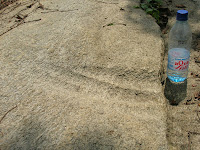
I recall finding a number of interesting erosional features on rocky outcrops along the coast of West Africa starting back in the 1990s. To me their identity was a mystery. Part of this was because my experiences in geology were initially the Canadian and European north, the High Arctic, and Antarctica. These are places where there are not a lot of anthropogenic structures, and those that were common tended to be sophisticated representational carvings or paintings. So I never thought at all about an anthropogenic origin for these things, but frustrated myself trying to think of natural events that would cause randomly oriented grooves on all these rocks in coastal West Africa.
Erosional features in Axim, Western Region, Ghana.
Grooves at Akonu Beach, Ghana (about 3 km east of Axim).
The real hotbed for these features was Dixcove, which is near the boundary between the western region and the central region of Ghana. The number of such features as well as their variability (different types and sizes) exceeded any site observed so far. Sadly, none of them are in situ, as the rocks have been quarried and formed into a breakwater.
Multiple grooves on a boulder in the breakwater at Dixcove. No real scale, sorry, but the white and blue paper at left is a wrapper for an ice cream bar.
The eye-opener came on a visit to the Primate Preservation Centre at Kakum (central region of Ghana) in November 2007, where these grooves are abundant and interpreted as stone-tool sharpening marks.
Kakum forest tool sharpening marks in gneiss. Site is atop an erosional remnant of bedrock, providing a good view of surrounding area. The 3-D nature of the grooves is apparent in the warp of the quartz vein (the white line in the picture at left).
I have seen interpretations suggesting that early habitation in West Africa was inland and on highlands. Certainly there are caves in the Kwahu area of Ghana supporting this idea. But after spending some years exploring in West Africa let me say that there is one very important reason to live near the coast.
Salt.
It is hard for modern people to appreciate the importance of, or the difficulty in finding, salt. Years of hiking and working in West Africa have forced me to learn first-hand the importance of maintaining salt levels in the body and the dire consequences of letting it drop. Muscle cramps are only the beginning. The improvement in health I experienced once I began strategically supplementing with salt was incredible, with an immediate reduction in cramping, gout, and an elimination of the occasional bout of traveller's diarrhea.
Salt was so precious that it has been traded weight for weight for gold. Clearly then, the coast would have been an important area, with its ready access to fish and salt. It is true that in the Volta Basin there are rocks which formed beneath an inland sea, so there would probably be salt-licks and salty soils available, the coast was where it was at.
With the amount of sea-level rise since the last glacial maximum, there may well be evidence for human habitation on what is now the West African continental shelf, similar to discoveries here and here.






I have also spent many happy hours searching for these grooves - and finding them at Kurofofrom West of Kumasi (hundreds), near Techiman, north of Kumasi, close to Enchi on the Eastern edge of lake Volta (a couple) and at Butre near Dixcove, and best of all a couple of grooves, and eight stone axe heads, in an hour's searching on a raised beach near Busua.
ReplyDeleteI believe - having seen them in photos - that they are also present in the far North.
It is possible that people were using stone tools, and polishing them, until relatively recent times.
The tools themselves can easily be found on any medicine stall and bought for a few cedis. They come in a variety of shapes and sizes.
Thanks. There are a lot of interesting stone age sites in coastal Ghana; but as you noted that doesn't mean they are very old.
DeleteI don't know if you saw these somewhat related postings.
http://www.worldcomplex.blogspot.ca/2011/01/identification-of-stone-artifacts-in.html
http://www.worldcomplex.blogspot.ca/2010/08/partial-history-of-hard-money-in-ghana.html (some photos near the end)